Effects of Different Straw Return Methods on the Soil Structure, Organic Carbon Content and Maize Yield of Black Soil Farmland
Abstract
:1. Introduction
2. Materials and Methods
2.1. Study Site
2.2. Experimental Design
2.3. Sampling and Measurement
2.3.1. Soil Sample Collection
2.3.2. Assessment of the Soil Samples
2.3.3. Maize Yield Determination
2.4. Data Calculation and Analysis
2.4.1. Formulas for the Previous Methods
2.4.2. Data Analysis
3. Results
3.1. Soil Bulk Density and Porosity
3.2. Soil Aggregate Content
3.2.1. Soil Force-Stabilized Aggregate Content
3.2.2. Soil Water-Stable Aggregate Content
3.3. Soil Aggregate Stability
3.3.1. Soil Aggregate Destruction Rate
3.3.2. Average Mass Diameter of Soil Aggregates
3.4. Organic Carbon Content and Carbon Preservation Capacity of Soil Aggregates
3.4.1. Organic Carbon Content of the Soil Aggregates
3.4.2. Carbon Preservation Capacity of Soil Aggregates
3.5. Soil Organic Carbon and Microbial Biomass Carbon Content
3.5.1. Soil Organic Carbon Content
3.5.2. Soil Microbial Biomass Carbon Content
3.6. Corn Production
3.7. Relationships between Soil Indicators and Maize Yield
4. Discussion
4.1. Effects of Different Straw Return Methods on Soil Porosity
4.2. Effects of Different Straw-Returning Methods on Soil Aggregate Fractions and Their Stability
4.3. Effects of Different Straw-Returning Methods on Aggregate Organic Carbon and Soil Organic Carbon
4.4. Effects of Different Straw Return Methods on the Corn Yield
5. Conclusions
Author Contributions
Funding
Data Availability Statement
Acknowledgments
Conflicts of Interest
References
- Zhang, B.; Song, X.; Zhang, Y.; Han, D.; Tang, C.; Yu, Y.; Ma, Y. Hydrochemical Characteristics and Water Quality Assessment of Surface Water and Groundwater in Songnen Plain, Northeast China. Water Res. 2012, 46, 2737–2748. [Google Scholar] [CrossRef] [PubMed]
- Qi, J.; Guo, M.; Zhou, P.; Zhang, X.; Xu, J.; Chen, Z.; Liu, X.; Wang, L.; Wan, Z. Soil Erosion Resistance Factors in Different Types of Gully Heads Developed in Four Main Land-Uses in the Mollisols Region of Northeast China. Soil Tillage Res. 2023, 230, 105697. [Google Scholar]
- Xie, Y.; Lin, H.; Ye, Y.; Ren, X. Changes in Soil Erosion in Cropland in Northeastern China over the Past 300 years. CATENA 2019, 176, 410–418. [Google Scholar] [CrossRef]
- Song, X.-D.; Yang, F.; Ju, B.; Li, D.-C.; Zhao, Y.-G.; Yang, J.-L.; Zhang, G.-L. The Influence of the Conversion of Grassland to Cropland on Changes in Soil Organic Carbon and Total Nitrogen Stocks in the Songnen Plain of Northeast China. CATENA 2018, 171, 588–601. [Google Scholar] [CrossRef]
- Cao, H.; Zhu, X.; Heijman, W.; Zhao, K. The Impact of Land Transfer and Farmers’ Knowledge of Farmland Protection Policy on pro-Environmental Agricultural Practices: The Case of Straw Return to Fields in Ningxia, China. J. Clean. Prod. 2020, 277, 123701. [Google Scholar] [CrossRef]
- Ota, H.O.; Mohan, K.C.; Udume, B.U.; Olim, D.M.; Okolo, C.C. Assessment of Land Use Management and Its Effect on Soil Quality and Carbon Stock in Ebonyi State, Southeast Nigeria. J. Environ. Manag. 2024, 358, 120889. [Google Scholar] [CrossRef]
- Duan, Y.; Chen, L.; Zhang, J.; Li, D.; Han, X.; Zhu, B.; Li, Y.; Zhao, B.; Huang, P. Long-Term Fertilisation Reveals Close Associations between Soil Organic Carbon Composition and Microbial Traits at Aggregate Scales. Agric. Ecosyst. Environ. 2021, 306, 107169. [Google Scholar] [CrossRef]
- Duan, L.; Sheng, H.; Yuan, H.; Zhou, Q.; Li, Z. Land Use Conversion and Lithology Impacts Soil Aggregate Stability in Subtropical China. Geoderma 2021, 389, 114953. [Google Scholar] [CrossRef]
- Bronick, C.J.; Lal, R. Soil Structure and Management: A Review. Geoderma 2005, 124, 3–22. [Google Scholar] [CrossRef]
- Ye, L.; Tan, W.; Fang, L.; Ji, L.; Deng, H. Spatial Analysis of Soil Aggregate Stability in a Small Catchment of the Loess Plateau, China: I. Spatial Variability. Soil Tillage Res. 2018, 179, 71–81. [Google Scholar] [CrossRef]
- Dou, X.; Zhang, C.; Zhang, J.; Ma, D.; Chen, L.; Zhou, G.; Duan, Y.; Tao, L.; Chen, J. Relationship between Calcium Forms and Organic Carbon Content in Aggregates of Calcareous Soils in Northern China. Soil Tillage Res. 2024, 244, 106210. [Google Scholar] [CrossRef]
- Zhang, J.; Zhang, F.; Yang, L. Continuous Straw Returning Enhances the Carbon Sequestration Potential of Soil Aggregates by Altering the Quality and Stability of Organic Carbon. J. Environ. Manag. 2024, 358, 120903. [Google Scholar] [CrossRef]
- Guo, Y.; Quan, W.; Yuan, P.; Liu, T.; Wang, J.; Cao, C. Variations in the Profile Distribution of Soil Aggregates and Organic Carbon under Rice-Crayfish Coculture System in Jianghan Plain, China. Soil Tillage Res. 2024, 243, 106175. [Google Scholar] [CrossRef]
- Zhu, X.; Xie, H.; Masters, M.D.; Rui, Y.; Luo, Y.; He, H.; Zhang, X.; Liang, C. Microorganisms, Their Residues, and Soil Carbon Storage under a Continuous Maize Cropping System with Eight Years of Variable Residue Retention. Appl. Soil Ecol. 2023, 187, 104846. [Google Scholar] [CrossRef]
- Anthony, M.A.; Crowther, T.W.; Maynard, D.S.; van den Hoogen, J.; Averill, C. Distinct Assembly Processes and Microbial Communities Constrain Soil Organic Carbon Formation. One Earth 2020, 2, 349–360. [Google Scholar] [CrossRef]
- Liang, Y.; Al-Kaisi, M.; Yuan, J.; Liu, J.; Zhang, H.; Wang, L.; Cai, H.; Ren, J. Effect of Chemical Fertilizer and Straw-Derived Organic Amendments on Continuous Maize Yield, Soil Carbon Sequestration and Soil Quality in a Chinese Mollisol. Agric. Ecosyst. Environ. 2021, 314, 107403. [Google Scholar] [CrossRef]
- Zhang, S.; Wang, Y.; Shen, Q. Influence of Straw Amendment on Soil Physicochemical Properties and Crop Yield on a Consecutive Mollisol Slope in Northeastern China. Water 2018, 10, 559. [Google Scholar] [CrossRef]
- Chang, F.; Wang, X.; Song, J.; Zhang, H.; Yu, R.; Wang, J.; Liu, J.; Wang, S.; Ji, H.; Li, Y. Maize Straw Application as an Interlayer Improves Organic Carbon and Total Nitrogen Concentrations in the Soil Profile: A Four-Year Experiment in a Saline Soil. J. Integr. Agric. 2023, 22, 1870–1882. [Google Scholar] [CrossRef]
- Gao, Y.; Feng, H.; Zhang, M.; Shao, Y.; Wang, J.; Liu, Y.; Li, C. Straw Returning Combined with Controlled-Release Nitrogen Fertilizer Affected Organic Carbon Storage and Crop Yield by Changing Humic Acid Composition and Aggregate Distribution. J. Clean. Prod. 2023, 415, 137783. [Google Scholar] [CrossRef]
- Wang, X.; Jia, Z.; Liang, L.; Zhao, Y.; Yang, B.; Ding, R.; Wang, J.; Nie, J. Changes in Soil Characteristics and Maize Yield under Straw Returning System in Dryland Farming. Field Crops Res. 2018, 218, 11–17. [Google Scholar] [CrossRef]
- Liang, F.; Li, B.; Vogt, R.D.; Mulder, J.; Song, H.; Chen, J.; Guo, J. Straw Return Exacerbates Soil Acidification in Major Chinese Croplands. Resour. Conserv. Recycl. 2023, 198, 107176. [Google Scholar] [CrossRef]
- Li, Y.; Feng, H.; Dong, Q.; Xia, L.; Li, J.; Li, C.; Zang, H.; Andersen, M.N.; Olesen, J.E.; Jørgensen, U.; et al. Ammoniated Straw Incorporation Increases Wheat Yield, Yield Stability, Soil Organic Carbon and Soil Total Nitrogen Content. Field Crops Res. 2022, 284, 108558. [Google Scholar] [CrossRef]
- Kallenbach, C.M.; Grandy, A.S.; Frey, S.D.; Diefendorf, A.F. Microbial Physiology and Necromass Regulate Agricultural Soil Carbon Accumulation. Soil Biol. Biochem. 2015, 91, 279–290. [Google Scholar] [CrossRef]
- Kan, Z.-R.; Liu, W.-X.; Liu, W.-S.; Lal, R.; Dang, Y.P.; Zhao, X.; Zhang, H.-L. Mechanisms of Soil Organic Carbon Stability and Its Response to No-till: A Global Synthesis and Perspective. Glob. Chang. Biol. 2022, 28, 693–710. [Google Scholar] [CrossRef] [PubMed]
- Liu, Y.; Zhao, X.; Liu, W.; Feng, B.; Lv, W.; Zhang, Z.; Yang, X.; Dong, Q. Plant Biomass Partitioning in Alpine Meadows under Different Herbivores as Influenced by Soil Bulk Density and Available Nutrients. CATENA 2024, 240, 108017. [Google Scholar] [CrossRef]
- Hu, X.; Chen, J.; Zhu, L. Soil Aggregate Size Distribution and Stability of Farmland as Affected by Dry and Wet Sieving Methods. Zemdirb.-Agric. 2020, 107, 179–184. [Google Scholar] [CrossRef]
- Emerson, W. A Classification of Soil Aggregates Based on Their Coherence in Water. Soil Res. 1967, 5, 47. [Google Scholar] [CrossRef]
- Wu, J.; Joergensen, R.G.; Pommerening, B.; Chaussod, R.; Brookes, P.C. Measurement of Soil Microbial Biomass C by Fumigation-Extraction—An Automated Procedure. Soil Biol. Biochem. 1990, 22, 1167–1169. [Google Scholar] [CrossRef]
- Hazra, K.K.; Nath, C.P.; Singh, U.; Praharaj, C.S.; Kumar, N.; Singh, S.S.; Singh, N.P. Diversification of Maize-Wheat Cropping System with Legumes and Integrated Nutrient Management Increases Soil Aggregation and Carbon Sequestration. Geoderma 2019, 353, 308–319. [Google Scholar] [CrossRef]
- Munkholm, L.J.; Heck, R.J.; Deen, B.; Zidar, T. Relationship between Soil Aggregate Strength, Shape and Porosity for Soils under Different Long-Term Management. Geoderma 2016, 268, 52–59. [Google Scholar] [CrossRef]
- Bi, M.; Zhang, S.; Xu, Q.; Hou, S.; Han, M.; Yu, X. Coupling and Synergistic Relationships between Soil Aggregate Stability and Nutrient Stoichiometric Characteristics under Different Microtopographies on Karst Rocky Desertification Slopes. CATENA 2024, 243, 108142. [Google Scholar] [CrossRef]
- Gupta Choudhury, S.; Srivastava, S.; Singh, R.; Chaudhari, S.K.; Sharma, D.K.; Singh, S.K.; Sarkar, D. Tillage and Residue Management Effects on Soil Aggregation, Organic Carbon Dynamics and Yield Attribute in Rice–Wheat Cropping System under Reclaimed Sodic Soil. Soil Tillage Res. 2014, 136, 76–83. [Google Scholar] [CrossRef]
- Yu, Q.; Wang, H.; Wen, P.; Wang, S.; Li, J.; Wang, R.; Wang, X. A suitable rotational conservation tillage system ameliorates soil physical properties and wheat yield: An 11-year in-situ study in a semi-arid agroecosystem. Soil Tillage Res. 2020, 199, 104600. [Google Scholar] [CrossRef]
- Rasa, K.; Tähtikarhu, M.; Miettinen, A.; Kähärä, T.; Uusitalo, R.; Mikkola, J.; Hyväluoma, J. A Large One-Time Addition of Organic Soil Amendments Increased Soil Macroporosity but Did Not Affect Intra-Aggregate Porosity of a Clay Soil. Soil Tillage Res. 2024, 242, 106139. [Google Scholar] [CrossRef]
- Bucka, F.B.; Koelbl, A.; Uteau, D.; Peth, S.; Kogel-Knabne, I. Organic Matter Input Determines Structure Development and Aggregate Formation in Artificial Soils. Geoderma 2019, 354, 113881. [Google Scholar] [CrossRef]
- Xu, X.; Pang, D.; Chen, J.; Luo, Y.; Zheng, M.; Yin, Y.; Li, Y.; Li, Y.; Wang, Z. Straw Return Accompany with Low Nitrogen Moderately Promoted Deep Root. Field Crop. Res. 2018, 221, 71–80. [Google Scholar] [CrossRef]
- Soon, Y.K.; Lupwayi, N.Z. Straw Management in a Cold Semi-Arid Region: Impact on Soil Quality and Crop Productivity. Field Crops Res. 2012, 139, 39–46. [Google Scholar] [CrossRef]
- Leskiw, L.A.; Welsh, C.M.; Zeleke, T.B. Effect of Subsoiling and Injection of Pelletized Organic Matter on Soil Quality and Productivity. Can. J. Soil. Sci. 2012, 92, 269–276. [Google Scholar] [CrossRef]
- Tisdall, J.M.; Oades, J.M. Organic Matter and Water-stable Aggregates in Soils. J. Soil Sci. 1982, 33, 141–163. [Google Scholar] [CrossRef]
- Xu, J.; Han, H.; Ning, T.; Li, Z.; Lal, R. Long-Term Effects of Tillage and Straw Management on Soil Organic Carbon, Crop Yield, and Yield Stability in a Wheat-Maize System. Field Crops Res. 2019, 233, 33–40. [Google Scholar] [CrossRef]
- Hurisso, T.T.; Davis, J.G.; Brummer, J.E.; Stromberger, M.E.; Mikha, M.M.; Haddix, M.L.; Booher, M.R.; Paul, E.A. Rapid Changes in Microbial Biomass and Aggregate Size Distribution in Response to Changes in Organic Matter Management in Grass Pasture. Geoderma 2013, 193–194, 68–75. [Google Scholar] [CrossRef]
- Pareja-Sánchez, E.; Plaza-Bonilla, D.; Ramos, M.C.; Lampurlanés, J.; Álvaro-Fuentes, J.; Cantero-Martínez, C. Long-Term No-till as a Means to Maintain Soil Surface Structure in an Agroecosystem Transformed into Irrigation. Soil Tillage Res. 2017, 174, 221–230. [Google Scholar] [CrossRef]
- Liu, H.; Crawford, M.; Carvalhais, L.C.; Dang, Y.P.; Dennis, P.G.; Schenk, P.M. Strategic Tillage on a Grey Vertosol after Fifteen Years of No-till Management Had No Short-Term Impact on Soil Properties and Agronomic Productivity. Geoderma 2016, 267, 146–155. [Google Scholar] [CrossRef]
- Yang, H.; Li, J.; Wu, G.; Huang, X.; Fan, G. Maize Straw Mulching with No-Tillage Increases Fertile Spike and Grain Yield of Dryland Wheat by Regulating Root-Soil Interaction and Nitrogen Nutrition. Soil Tillage Res. 2023, 228, 105652. [Google Scholar] [CrossRef]
- Li, J.; Yuan, X.; Ge, L.; Li, Q.; Li, Z.; Wang, L.; Liu, Y. Rhizosphere Effects Promote Soil Aggregate Stability and Associated Organic Carbon Sequestration in Rocky Areas of Desertification. Agric. Ecosyst. Environ. 2020, 304, 107126. [Google Scholar] [CrossRef]
- Liu, Y.; Ma, M.; Ran, Y.; Yi, X.; Wu, S.; Huang, P. Disentangling the Effects of Edaphic and Vegetational Properties on Soil Aggregate Stability in Riparian Zones along a Gradient of Flooding Stress. Geoderma 2021, 385, 114883. [Google Scholar] [CrossRef]
- Wang, W.; Guo, W.; Dong, J.; Zhang, H.; Liao, Y.; Wen, X. Ridge-Furrow Planting Patterns with Film Mulching Improve Water Use Efficiency by Enhancing Arbuscular Mycorrhizal Fungi in the Rhizosphere and Endophyte of Summer Maize. Agric. Water Manag. 2024, 296, 108802. [Google Scholar] [CrossRef]
- Li, C.; Luo, X.; Li, Y.; Wang, N.; Zhang, T.; Dong, Q.; Feng, H.; Zhang, W.; Siddique, K.H.M. Ridge Planting with Transparent Plastic Mulching Improves Maize Productivity by Regulating the Distribution and Utilization of Soil Water, Heat, and Canopy Radiation in Arid Irrigation Area. Agric. Water Manag. 2023, 280, 108230. [Google Scholar] [CrossRef]
- Six, J.; Elliott, E.T.; Paustian, K. Soil Macroaggregate Turnover and Microaggregate Formation: A Mechanism for C Sequestration under No-Tillage Agriculture. Soil Biol. Biochem. 2000, 32, 2099–2103. [Google Scholar] [CrossRef]
- Thorburn, P.J.; Meier, E.A.; Collins, K.; Robertson, F.A. Changes in Soil Carbon Sequestration, Fractionation and Soil Fertility in Response to Sugarcane Residue Retention Are Site-Specific. Soil Tillage Res. 2012, 120, 99–111. [Google Scholar] [CrossRef]
- Song, X.; Yuan, Z.-Q.; Fang, C.; Hu, Z.-H.; Li, F.-M.; Sardans, J.; Penuelas, J. The Formation of Humic Acid and Micro-Aggregates Facilitated Long-Time Soil Organic Carbon Sequestration after Medicago sativa L. Introd. Abandon. Farmlands. Geoderma 2024, 445, 116889. [Google Scholar]
- Smith, R.; Tongway, D.; Tighe, M.; Reid, N. When Does Organic Carbon Induce Aggregate Stability in Vertosols? Agric. Ecosyst. Environ. 2015, 201, 92–100. [Google Scholar] [CrossRef]
- Aoyama, M.; Angers, D.A.; N’Dayegamiye, A. Particulate and Mineral-Associated Organic Matter in Water-Stable Aggregates as Affected by Mineral Fertilizer and Manure Applications. Can. J. Soil. Sci. 1999, 79, 295–302. [Google Scholar] [CrossRef]
- Arthur, E.; Tuller, M.; Norgaard, T.; Moldrup, P.; Chen, C.; Ur Rehman, H.; Weber, P.L.; Knadel, M.; Wollesen de Jonge, L. Contribution of Organic Carbon to the Total Specific Surface Area of Soils with Varying Clay Mineralogy. Geoderma 2023, 430, 116314. [Google Scholar] [CrossRef]
- He, Y.T.; Zhang, W.J.; Xu, M.G.; Tong, X.G.; Sun, F.X.; Wang, J.Z.; Huang, S.M.; Zhu, P.; He, X.H. Long-Term Combined Chemical and Manure Fertilizations Increase Soil Organic Carbon and Total Nitrogen in Aggregate Fractions at Three Typical Cropland Soils in China. Sci. Total Environ. 2015, 532, 635–644. [Google Scholar] [CrossRef]
- Yan, Y.; Ji, W.; Li, B.; Wang, G.; Hu, B.; Zhang, C.; Mouazen, A.M. Effects of Long-Term Straw Return and Environmental Factors on the Spatiotemporal Variability of Soil Organic Matter in the Black Soil Region: A Case Study. Agronomy 2022, 12, 2532. [Google Scholar] [CrossRef]
- Yang, C.; Wang, X.; Li, J.; Zhang, G.; Shu, H.; Hu, W.; Han, H.; Liu, R.; Guo, Z. Straw Return Increases Crop Production by Improving Soil Organic Carbon Sequestration and Soil Aggregation in a Long-Term Wheat–Cotton Cropping System. J. Integr. Agric. 2024, 23, 669–679. [Google Scholar] [CrossRef]
- Li, F.-M.; Wang, J.; Xu, J.-Z.; Xu, H.-L. Productivity and Soil Response to Plastic Film Mulching Durations for Spring Wheat on Entisols in the Semiarid Loess Plateau of China. Soil Tillage Res. 2004, 78, 9–20. [Google Scholar] [CrossRef]
- Qin, W.; Niu, L.; You, Y.; Cui, S.; Chen, C.; Li, Z. Effects of Conservation Tillage and Straw Mulching on Crop Yield, Water Use Efficiency, Carbon Sequestration and Economic Benefits in the Loess Plateau Region of China: A Meta-Analysis. Soil Tillage Res. 2024, 238, 106025. [Google Scholar] [CrossRef]
- de Oliveira, J.A.T.; Cássaro, F.A.M.; Pires, L.F. Estimating Soil Porosity and Pore Size Distribution Changes Due to Wetting-Drying Cycles by Morphometric Image Analysis. Soil Tillage Res. 2021, 205, 104814. [Google Scholar] [CrossRef]
- Ghuman, B.S.; Sur, H.S. Tillage and Residue Management Effects on Soil Properties and Yields of Rainfed Maize and Wheat in a Subhumid Subtropical Climate. Soil Tillage Res. 2001, 58, 1–10. [Google Scholar] [CrossRef]
- Hansen, V.; Müller-Stöver, D.; Imparato, V.; Krogh, P.H.; Jensen, L.S.; Dolmer, A.; Hauggaard-Nielsen, H. The Effects of Straw or Straw-Derived Gasification Biochar Applications on Soil Quality and Crop Productivity: A Farm Case Study. J. Environ. Manag. 2017, 186, 88–95. [Google Scholar] [CrossRef] [PubMed]
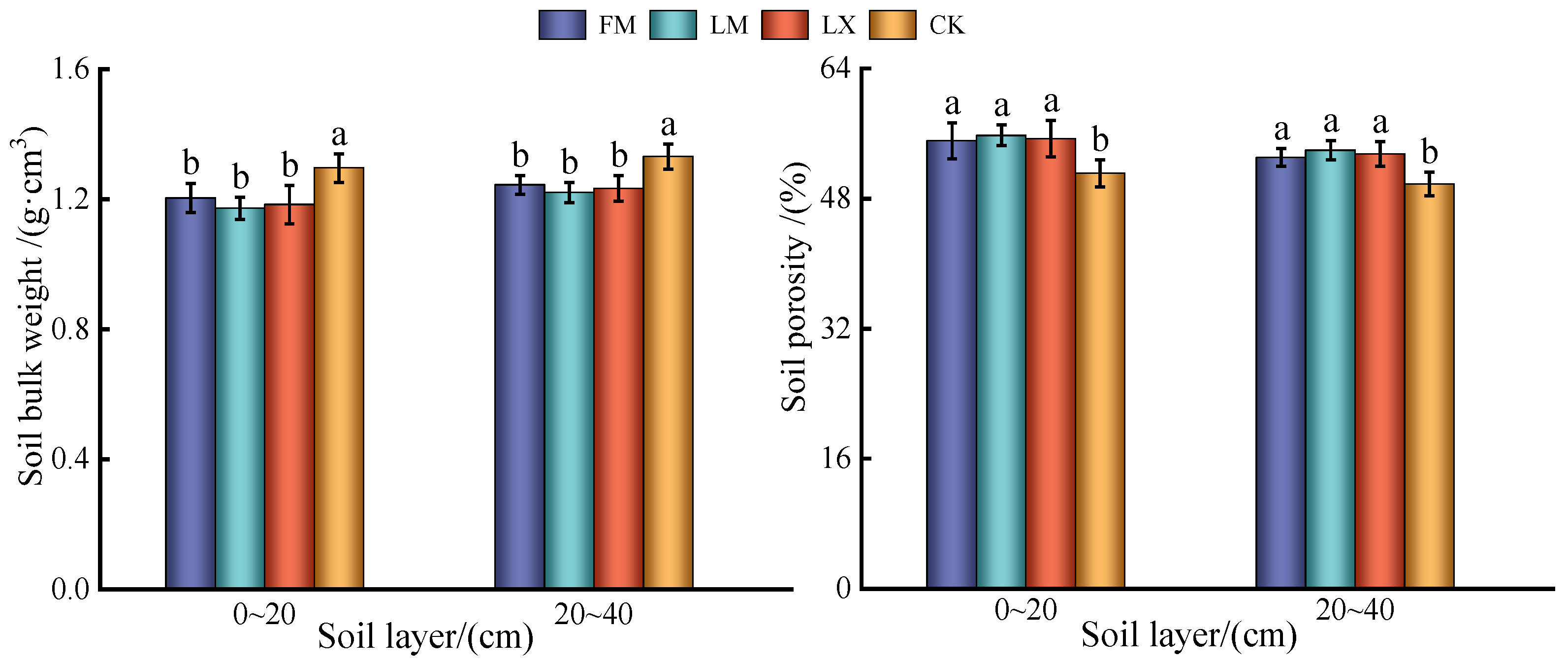
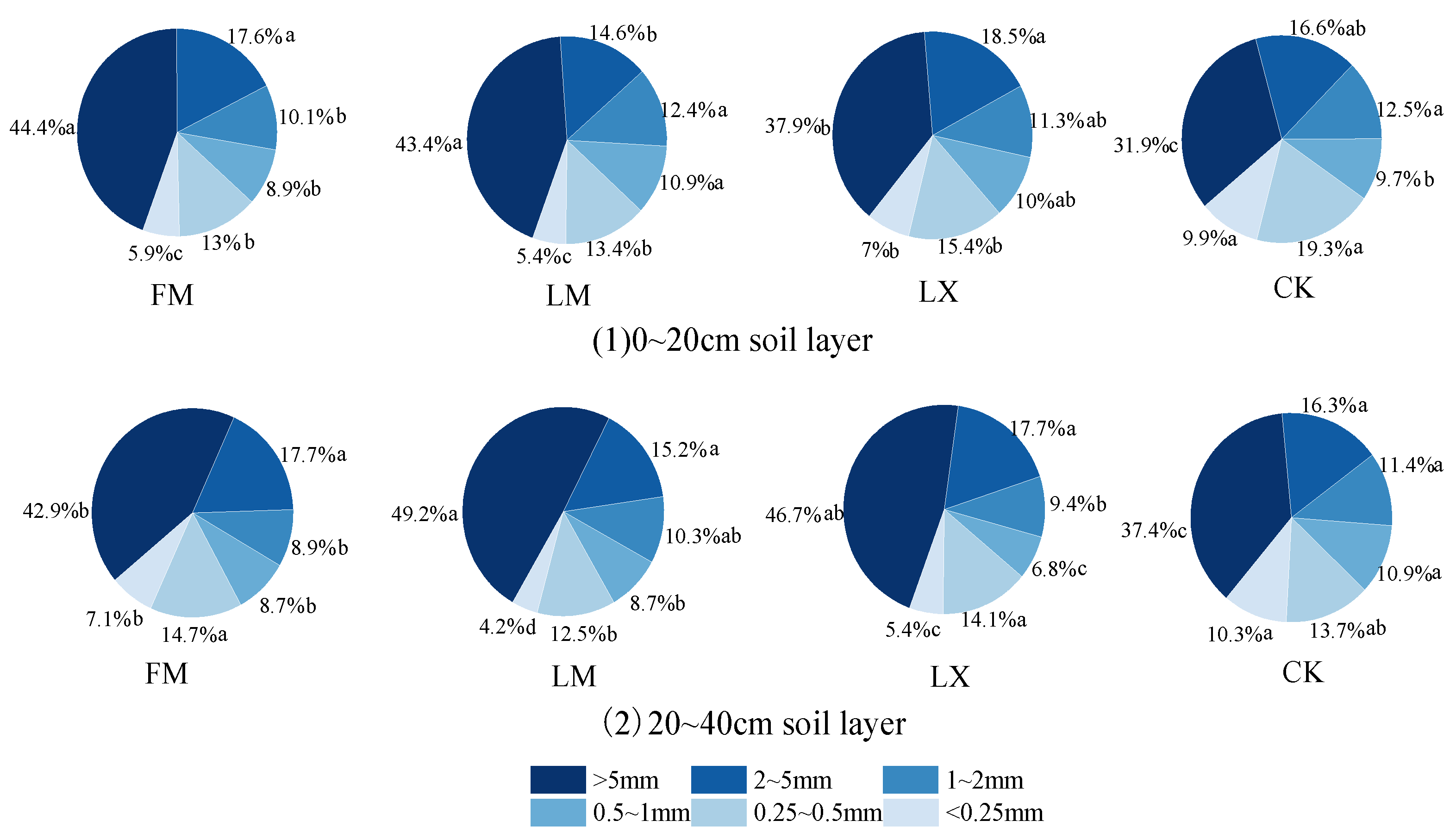
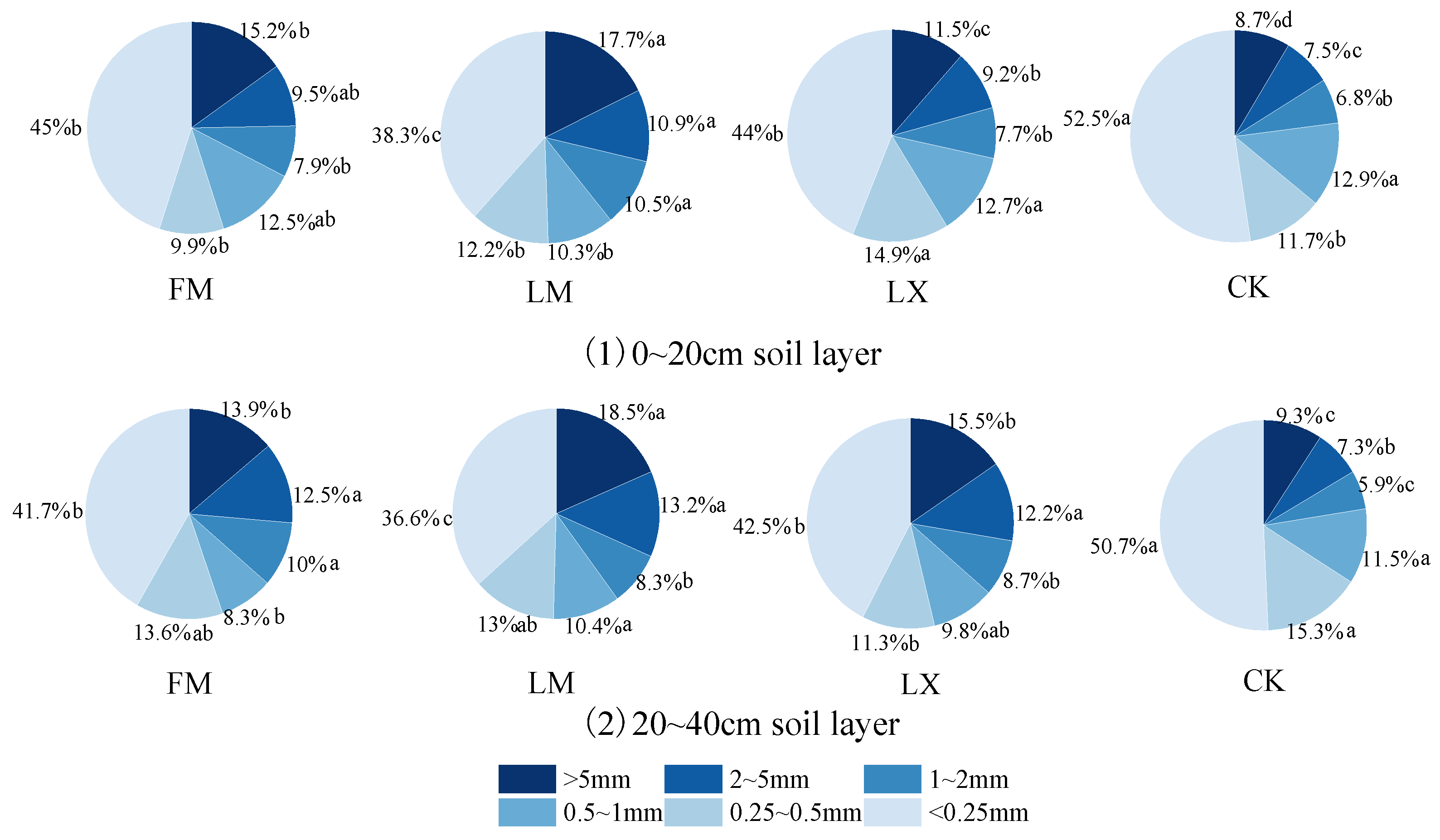
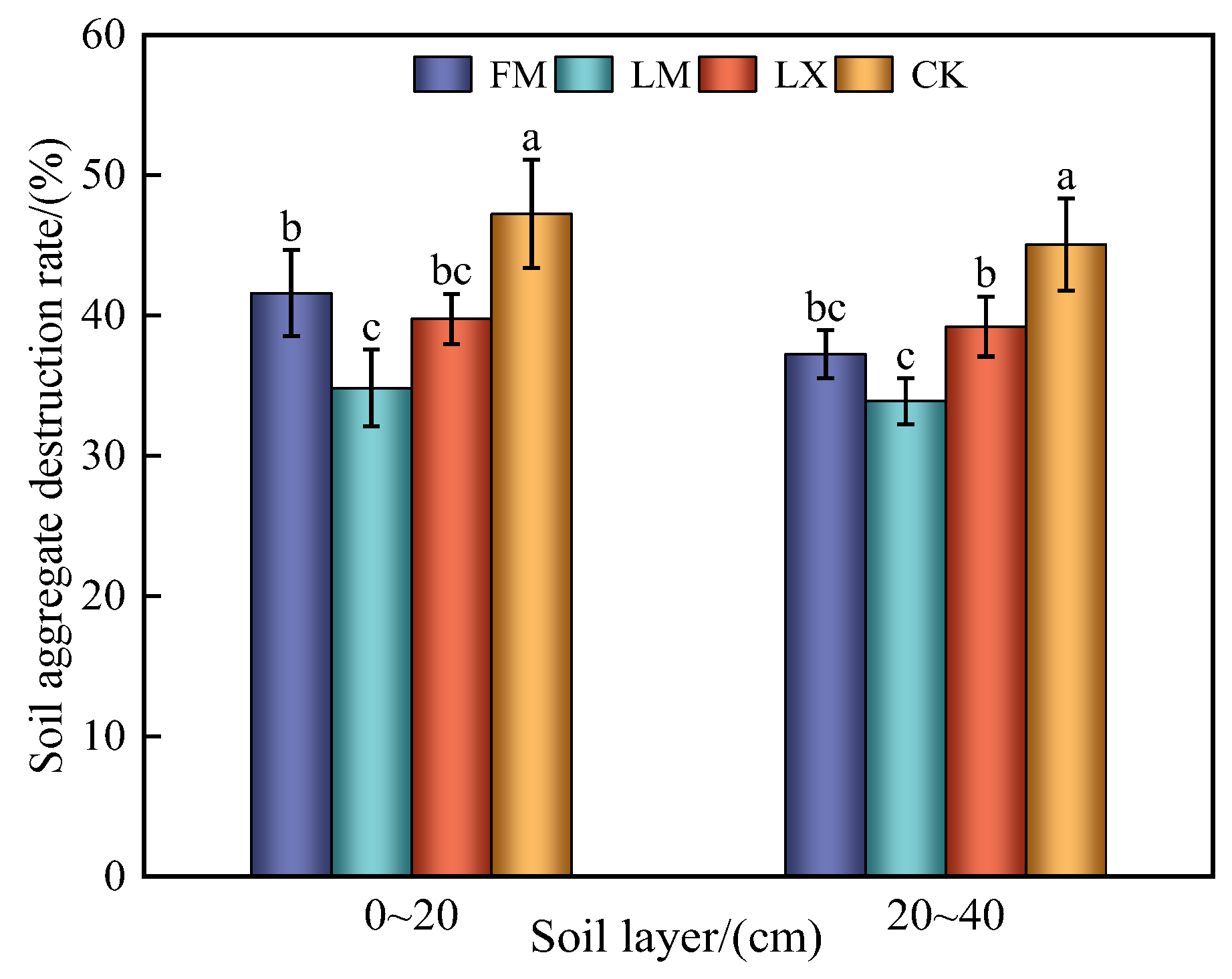

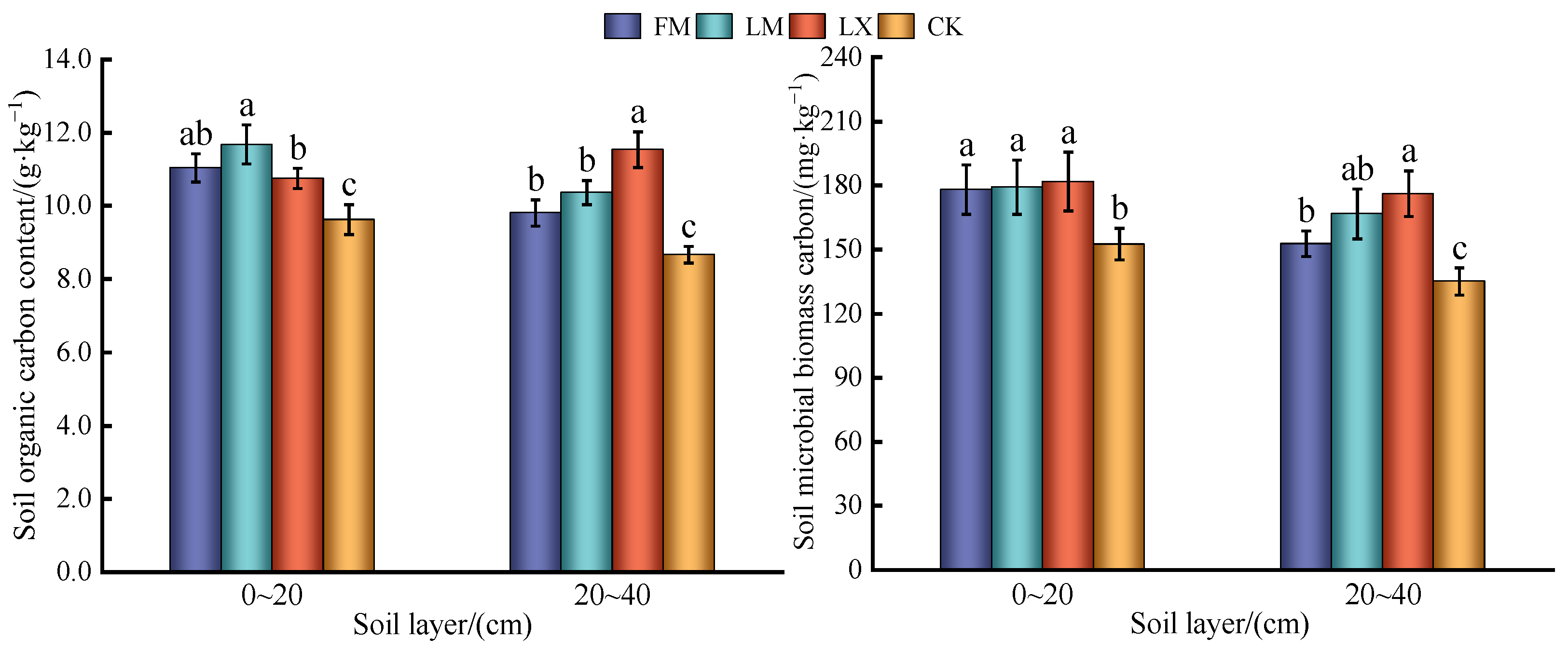
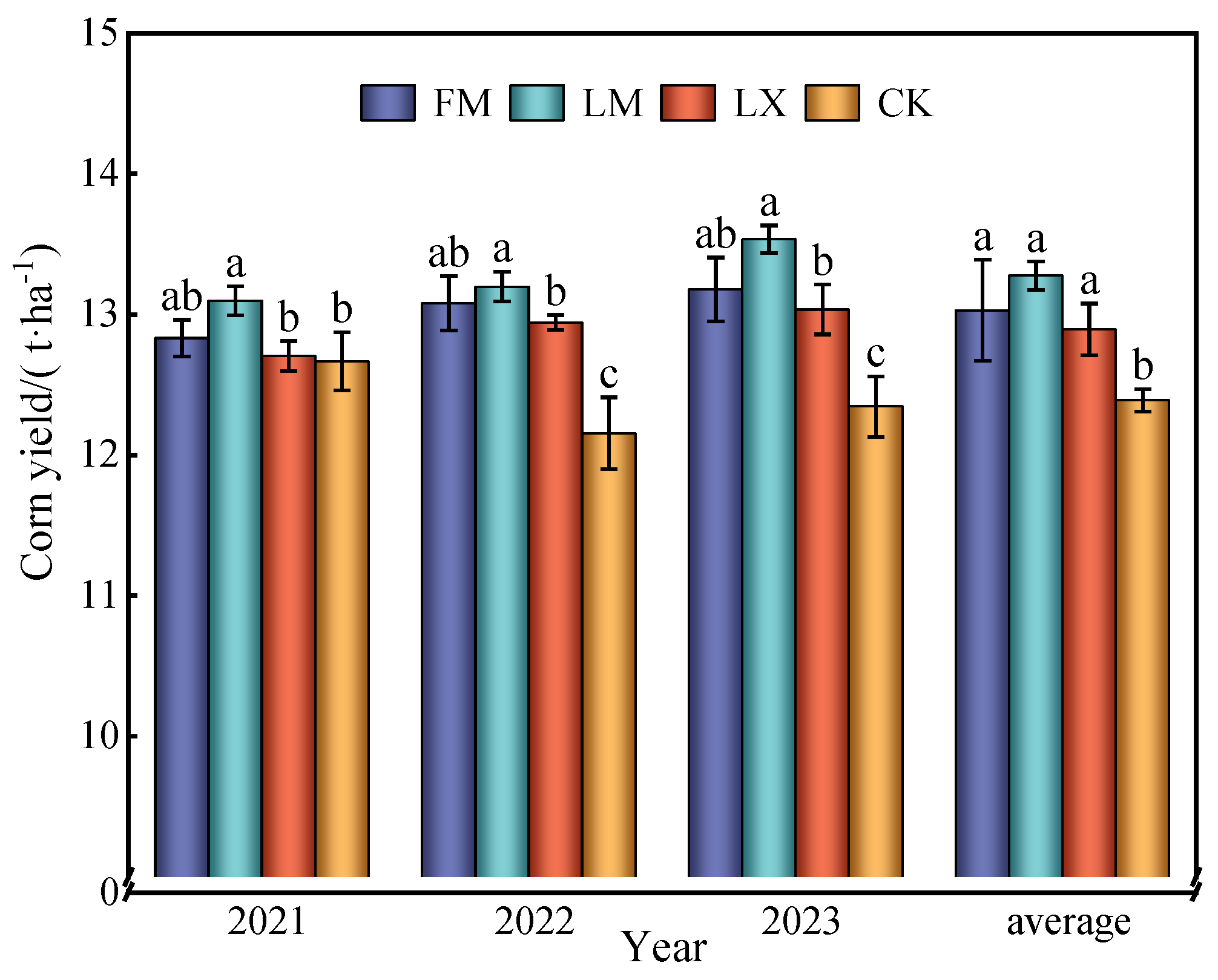
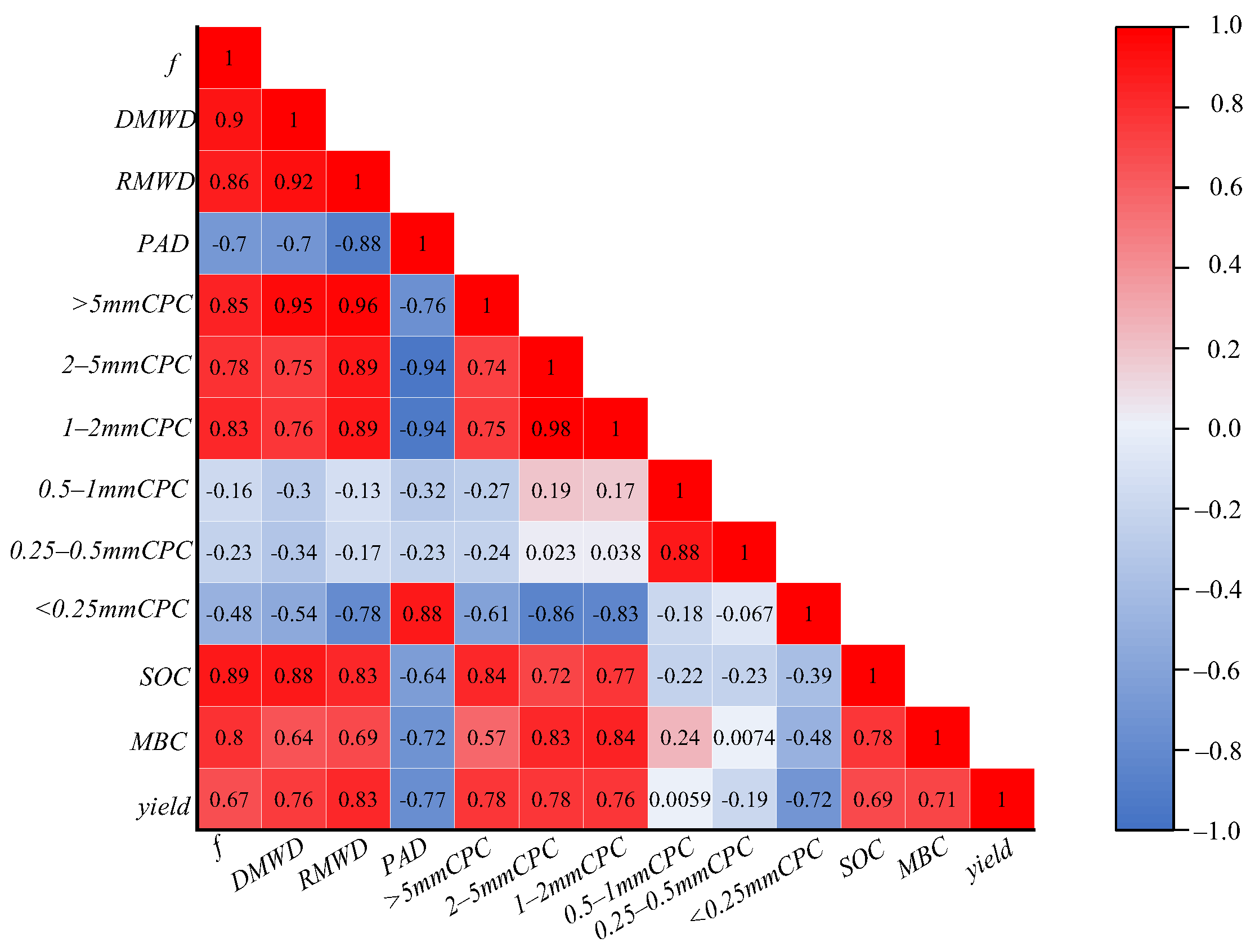
| Soil Depth/ (cm) | pH | Available Nitrogen/ (mg·kg−1) | Available Phosphorus/ (mg·kg−1) | Available Potassium/ (mg·kg−1) | Organic Matter/ (g·kg−1) |
|---|---|---|---|---|---|
| 0~20 | 7.3 | 154 | 40.2 | 377 | 25.3 |
| 20~40 | 7.2 | 150 | 37.1 | 357 | 23.0 |
| Soil Layer/(cm) | Treatment | Organic Carbon Content under Different Grain Sizes /(g·kg−1) | |||||
|---|---|---|---|---|---|---|---|
| >5 mm | 2~5 mm | 1~2 mm | 0.5~1 mm | 0.25~0.5 mm | <0.25 mm | ||
| 0~20 | FM | 12.12 a | 12.76 ab | 12.14 bc | 11.50 a | 10.42 ab | 9.51 b |
| LM | 12.44 a | 13.26 a | 12.60 ab | 11.80 a | 11.00 a | 10.55 a | |
| LX | 11.94 a | 11.92 b | 13.03 a | 10.86 b | 10.17 b | 9.55 b | |
| CK | 10.99 b | 10.81 c | 11.44 c | 10.66 b | 10.03 b | 8.94 b | |
| 20~40 | FM | 11.78 b | 12.23 b | 12.35 b | 12.12 b | 10.27 a | 8.37 c |
| LM | 12.21 ab | 13.05 a | 13.96 a | 12.86 a | 10.17 a | 8.92 b | |
| LX | 12.53 a | 13.15 a | 13.93 a | 12.58 ab | 10.45 a | 9.89 a | |
| CK | 10.79 c | 11.97 b | 11.22 c | 10.36 c | 9.95 a | 8.00 c | |
| Soil Layer/(cm) | Treatment | Carbon Preservation Capacity of the Soil Aggregates under Different Grain Sizes /(g·kg−1) | |||||
|---|---|---|---|---|---|---|---|
| >5 mm | 2~5 mm | 1~2 mm | 0.5~1 mm | 0.25~0.5 m | <0.25 mm | ||
| 0~20 | FM | 1.84 b | 1.22 ab | 0.95 b | 1.43 a | 1.04 c | 4.29 ab |
| LM | 2.21 a | 1.45 a | 1.33 a | 1.21 b | 1.34 ab | 4.05 b | |
| LX | 1.38 c | 1.10 b | 1.01 b | 1.38 ab | 1.51 a | 4.20 ab | |
| CK | 0.95 d | 0.81 c | 0.78 c | 1.37 ab | 1.17 bc | 4.68 a | |
| 20~40 | FM | 1.64 b | 1.53 a | 1.24 a | 1.01 b | 1.39 ab | 3.49 b |
| LM | 2.26 a | 1.72 a | 1.16 a | 1.34 a | 1.32 ab | 3.26 b | |
| LX | 1.94 ab | 1.60 a | 1.22 a | 1.23 a | 1.18 b | 4.20 a | |
| CK | 1.00 c | 0.87 b | 0.67 b | 1.20 ab | 1.52 a | 4.05 a | |
Disclaimer/Publisher’s Note: The statements, opinions and data contained in all publications are solely those of the individual author(s) and contributor(s) and not of MDPI and/or the editor(s). MDPI and/or the editor(s) disclaim responsibility for any injury to people or property resulting from any ideas, methods, instructions or products referred to in the content. |
© 2024 by the authors. Licensee MDPI, Basel, Switzerland. This article is an open access article distributed under the terms and conditions of the Creative Commons Attribution (CC BY) license (https://creativecommons.org/licenses/by/4.0/).
Share and Cite
Xu, J.; Song, F.; Wang, Z.; Qi, Z.; Liu, M.; Guan, S.; Sun, J.; Li, S.; Zhao, J. Effects of Different Straw Return Methods on the Soil Structure, Organic Carbon Content and Maize Yield of Black Soil Farmland. Agronomy 2024, 14, 2011. https://doi.org/10.3390/agronomy14092011
Xu J, Song F, Wang Z, Qi Z, Liu M, Guan S, Sun J, Li S, Zhao J. Effects of Different Straw Return Methods on the Soil Structure, Organic Carbon Content and Maize Yield of Black Soil Farmland. Agronomy. 2024; 14(9):2011. https://doi.org/10.3390/agronomy14092011
Chicago/Turabian StyleXu, Jingwen, Fang Song, Ziwen Wang, Zhijuan Qi, Ming Liu, Sheng Guan, Jialu Sun, Sirui Li, and Jianbao Zhao. 2024. "Effects of Different Straw Return Methods on the Soil Structure, Organic Carbon Content and Maize Yield of Black Soil Farmland" Agronomy 14, no. 9: 2011. https://doi.org/10.3390/agronomy14092011





